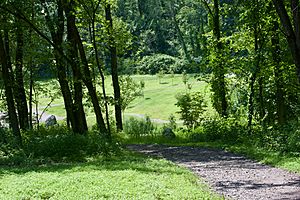Pittsburgh Botanic Garden facts for kids
The Pittsburgh Botanic Garden is a huge botanical garden located in Settler's Cabin Park near Pittsburgh, United States. It stretches across 452 acres, making it one of the top 10 largest botanical gardens in America! It's a special place where you can explore many different kinds of plants and natural areas.
Contents
History of the Garden
The land where the garden now sits was owned by the McGill family since the mid-1800s. In 1971, they sold about 85 acres to Allegheny County for Settler's Cabin Park. Later, the county had extra land and almost sold it for a golf course.
Around the same time, in 1988, a group of people who loved plants started the Horticultural Society of Western Pennsylvania. They wanted to teach others about horticulture (gardening) and botany (the study of plants). Their biggest dream was to create a botanical garden in Western Pennsylvania.
Their dream came true when the golf course plans fell through. The county offered the land to the Horticultural Society. The organization officially became a non-profit group in 1991. In 2010, it changed its name to the Pittsburgh Botanic Garden. It's the first large outdoor botanical garden in the area that focuses on plants that grow well in Western Pennsylvania's soil and climate.
Building and Fixing the Land
Cleaning the Water
After getting the land, the society found a big problem: nearly a century of underground coal mining and oil wells had damaged the soil. In 2004, Hurricane Ivan flooded the old mines, making the problem worse with "acid mine drainage." This is when water from mines becomes very acidic and can harm plants and animals.
Experts said it would take years and lots of money to clean up the land. To help with costs, the garden's board looked for grants and a company to remove coal and treat the acidic water. In 2008, Mashuda Corporation was hired to do this important work.
By 2012, a special system was built to clean the acid mine drainage, helping to restore a pond in the Woodland Gardens. That same year, a huge underground tank was built to hold 400,000 gallons of water. This water would be used for irrigation, so the garden wouldn't have to rely on city water.
Using Old Buildings Again
The garden's welcome center is in a barn built in the 1870s. This old barn was fixed up to include classrooms, an orientation area, and restrooms. The upper floor can even be used for special events like weddings.
Across from the welcome center, an old farmhouse is being turned into the garden's offices. This helps save history while creating new spaces.
Planting New Trees
Since 2010, about 20 acres of land have been cleared of plants that don't belong there (called invasive species). Over 5,200 native trees, shrubs, and other plants have been planted. This helps bring the natural environment back to life.
Garden Areas and Features
The garden officially started construction on August 1, 2006. It will be opened to the public in three main stages.
First Stage: Big Plans
The first stage is the largest part of the garden's master plan. It was expected to be finished by 2015.
This stage includes the welcome center, parking areas, and a family garden. The family garden even has a "Fred Rogers Garden of Make Believe," inspired by the famous children's TV host. A 40-acre area called the "Woodlands of the World" is also part of this stage. This area will have five different forest gardens, including:
- An Appalachian Plateau and Cove Forest, like those found in the eastern U.S.
- An Eastern European forest with a 25-foot dragon made of cob (a natural building material). This reminds visitors of old fairy tales.
- An English forest.
- A Japanese garden with a lotus pond, designed by famous garden designers.
Plant Growing and Research Center
In 2011, the Sprout Tree Nursery was built. It has a greenhouse, storage shed, and composter. This nursery helps the garden grow its own plants and save money. They can grow young trees and special plants like new types of American Chestnut, Black Walnuts, and various oaks. The nursery even uses a solar-powered system to water the plants!
Historic Homestead Area
This area features a log cabin built in 1784, which belonged to a Revolutionary War veteran named Isaac Walker. There's also a farmhouse from 1855.
An orchard nearby has young apple trees planted from very old types of apples. Some of these apple species date back to the 1500s! One type was even a favorite of Thomas Jefferson. A "pioneer garden" was built near the log cabin in 2014. It shows what gardens were like for early settlers and is fun and educational.
Dogwood Meadow
Thanks to grants, an eight-acre meadow was created. It has over 550 native white-flowering dogwood trees. This is a very special collection because many dogwood trees have been lost to disease over the years. In spring, the meadow is beautiful with dogwood flowers, bulbs, and other native shrubs.
This meadow is located between the Woodlands of the World and the historic homestead. There are plans to build a gazebo and a small ornamental garden here. These spots will be perfect for weddings, parties, or classes.
Other Future Plans
The garden also plans to build an amphitheater for outdoor performances. In total, there will be 18 different themed gardens for visitors to explore.
See also
 In Spanish: Jardín botánico de Pittsburgh para niños
In Spanish: Jardín botánico de Pittsburgh para niños


